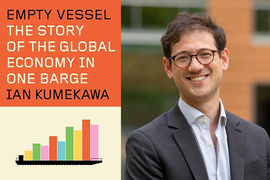Audio
In 1989, New York City opened a new jail. But not on dry land. The city leased a barge, then called the “Bibby Resolution,” which had been topped with five stories of containers made into housing, and anchored it in the East River. For five years, the vessel lodged inmates.
A floating detention center is a curiosity. But then, the entire history of this barge is curious. Built in 1979 in Sweden, it housed British troops during the Falkland Islands war with Argentina, became worker housing for Volkswagen employees in West Germany, got sent to New York, also became a detention center off the coast of England, then finally was deployed as oil worker housing off the coast of Nigeria. The barge has had nine names, several owners, and flown the flags of five countries.
In this one vessel, then, we can see many currents: globalization, the transience of economic activity, and the hazy world of transactions many analysts and observers call “the offshore,” the lightly regulated sphere of economic activity that encourages short-term actions.
“The offshore presents a quick and potentially cheap solution to a crisis,” says MIT lecturer Ian Kumekawa. “It is not a durable solution. The story of the barge is the story of it being used as a quick fix in all sorts of crises. Then these expediences become the norm, and people get used to them and have an expectation that this is the way the world works.”
Now Kumekawa, a historian who started teaching as a lecturer at MIT earlier this year, explores the ship’s entire history in “Empty Vessel: The Global Economy in One Barge,” just published by Knopf and John Murray. In it, he traces the barge’s trajectory and the many economic and geopolitical changes that helped create the ship’s distinctive deployments around the world.
“The book is about a barge, but it’s also about the developing, emerging offshore world, where you see these layers of globalization, financialization, privatization, and the dissolution of territoriality and orders,” Kumekawa says. “The barge is a vehicle through which I can tell the story of those layers together.”
“Never meant to be permanent”
Kumekawa first found out about the vessel several years ago; New York City obtained another floating detention center in the 1990s, which prompted Kumekawa to start looking into the past of the older jail ship, the former “Bibby Resolution,” from the 1990s. The more he found out about its distinctive past, the more curious he became.
“You start pulling on a thread, and you realize you can keep pulling,” Kumekawa says.
The barge Kumekawa follows in the book was built in Sweden in 1979 as the “Balder Scapa.” Even then, commerce was plenty globalized: The vessel was commissioned by a Norwegian shell company, with negotiations run by an expatriate Swedish shipping agent whose firm was registered in Panama and used a Miami bank.
The barge was built at an inflection point following the economic slowdown and oil shocks of the 1970s. Manufacturing was on the verge of declining in both Western Europe and the U.S.; about half as many people now work in manufacturing in those regions, compared to 1960. Companies were looking to find cheaper global locations for production, reinforcing the sense that economic activity was now less durable in any given place.
The barge became part of this transience. The five-story accommodation block was added in the early 1980s; in 1983 it was re-registered in the UK and sent to the Falkland Islands as a troop accommodation named the “COASTEL 3.” Then it was re-registered in the Bahamas and sent to Emden, West Germany, as housing for Volkswagen workers. The vessel then served its stints as inmate housing — first in New York, then off the coast of England from 1997 to 2005. By 2010, it had been re-re-re-registered, in St. Vincent and Grenadines, and was housing oil workers off the coast of Nigeria.
“Globalization is more about flow than about stocks, and the barge is a great example of that,” Kumekawa says. “It’s always on the move, and never meant to be a permanent container. It’s understood people are going to be passing through.”
As Kumekawa explores in the book, this sense of social dislocation overlapped with the shrinking of state capacity, as many states increasingly encouraged companies to pursue globalized production and lightly regulated financial activities in numerous jurisdictions, in the hope it would enhance growth. And it has, albeit with unresolved questions about who the benefits accrue to, the social dislocation of workers, and more.
“In a certain sense it’s not an erosion of state power at all,” Kumekawa says. “These states are making very active choices to use offshore tools, to circumvent certain roadblocks.” He adds: “What happens in the 1970s and certainly in the 1980s is that the offshore comes into its own as an entity, and didn’t exist in the same way even in the 1950s and 1960s. There’s a money interest in that, and there’s a political interest as well.”
Abstract forces, real materials and people
Kumekawa is a scholar with a strong interest in economic history; his previous book, “The First Serious Optimist: A.C. Pigou and the Birth of Welfare Economics,” was published in 2017. This coming fall, Kumekawa will be team-teaching a class on the relationship between economics and history, along with MIT economists Abhijit Banerjee and Jacob Moscona.
Working on “Empty Vessel” also necessitated that Kumekawa use a variety of research techniques, from archival work to journalistic interviews with people who knew the vessel well.
“I had a wonderful set of conversations with the man who was the last bargemaster,” Kumekawa says. “He was the person in effect steering the vessel for many years. He was so aware of all of the forces at play — the market for oil, the prices of accommodations, the regulations, the fact no one had reinforced the frame.”
“Empty Vessel” has already received critical acclaim. Reviewing it in The New York Times, Jennifer Szalai writes that this “elegant and enlightening book is an impressive feat.”
For his part, Kumekawa also took inspiration from a variety of writings about ships, voyages, commerce, and exploration, recognizing that these vessels contain stories and vignettes that illuminate the wider world.
“Ships work very well as devices connecting the global and the local,” he says. Using the barge as the organizing principle of his book, Kumekawa adds, “makes a whole bunch of abstract processes very concrete. The offshore itself is an abstraction, but it’s also entirely dependent on physical infrastructure and physical places. My hope for the book is it reinforces the material dimension of these abstract global forces.”










